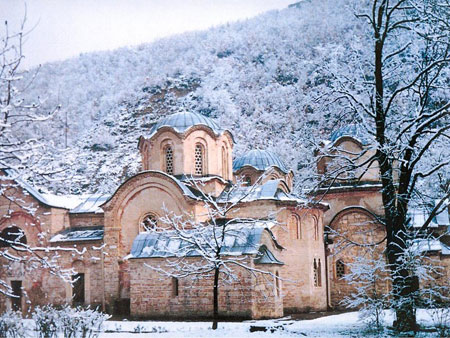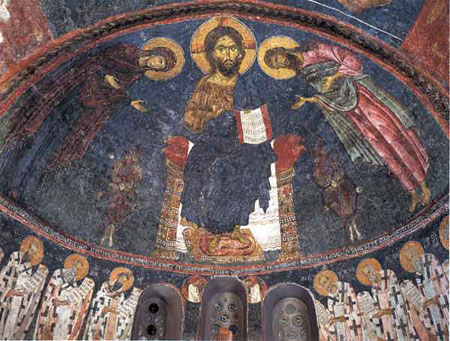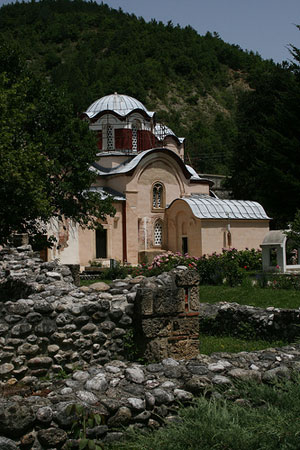The Monastery of the Patriarchate of Pec - Пећка Патријаршија
The Monastery of the Patriarchate of Pec
The Monastery of the Patriarchate of Pec is located at the very entrance of the Rugova gorge near Pec. The complex of the Pec churches is the spiritual seat and mausoleum of Serbian archbishops and patriarchs. The temple of the Holy Apostles was built by Archbishop Arsenije I in the third decade of the 13th century. He was also responsible for the painting of the church around 1260. Archbishop Nikodim built the temple of St. Dimitrije next to the northern side of the church of Holy Apostles between 1321 and 1324, while Archbishop Danilo II built the churches dedicated to Virgin Odigitrija and St. Nikola on its southern side. He also built the monumental parvis in the shape of a magnificent open porch in front of the western facades of the churches of St. Dimitrije, Holy Apostles and Holy Virgin Odigitrija. At the time of Patriarch Makarije, the elegant openings with dual arcades were walled up. An entire history of the styles of medieval wall painting can be seen on the walls of the Pec churches. The church of the Holy Apostles was also decorated around 1300, then around 1350 and 1375 and twice in the 17th century. The church of St. Dimitrije was painted for the first time at the time of Patriarch Joakinije, around 1345, and the new layer of frescoes was painted by Georgije Mitrofanovic around 1619-1620. The church of Holy Virgin Odigitrija was painted before 1337, while its parvis was painted in the 14th and 16th centuries. The church of St. Nikola was painted by painter Radul in 1673/1674.
As a result of severe Turkish repression Patriarch Arsenios III left Pec with several thousand Christian families and emigrated to southern Hungary at the end of 17th century. Despite pressure from the local Moslem population the monastery has been preserved until today. After the Second World War the Patriarchate of Pec was converted into a convent. Although this monastery jurisdictionally does not belong to the Diocese of Raska and Prizren it is nevertheless closely tied to the monasteries of the Diocese. As a stavropegic monastery it is directly under the jurisdiction of the Serbian Orthodox Patriarch from Belgrade.
Today, the monastery is still one of the most important Serbian Orthodox centers in the Region with the sisterhood of 24 nuns. After the fire which was set by Albanian extremists in 1981 new residental quarters were erected. After the war 1998-1999 the monastery became an important center for the remaining Serbs in the area. At the moment in Pec town only these nuns remain. They live in everyday struggle to preserve this holy site and provide necessary humanitarian assistance to the neigboring Serb enclaves of Gorazdevac and Osojane. The monastery also owns the metochion of Budisavci, near Klina where two nuns remain under the constant KFOR protection.
The Church of St Demetrius was founded by Archbishop Nikodim (1317-1324). Not big in size, it has the form of a shortened cross with a spacious dome. It was built in alternate courses of brick and stone. The entrance is framed with a harmonious stone portal. Joanikije is to be credited for the frescoes painted towards the middle of the 11th c. The were renovated in early 17th c. They consist of valuable portraits of Emperor Dusan, his son Uros V and Patriarch Joanikije, and also a worthy composition of two Serbian Councils on a vault in the western part. The church houses the relics of patriarchs Jefrem and Sava IV.
The Church of the Virgin Hodegetria was built next to the southern side of the Holy Apostles, c. 1300. It was commissioned by Danilo II, to counterpart the church of St Demetrius. The ground plan has the form of a floral cross with an octagonal dome borne by four free standing pillars. The temple is partioned into three longitudinal spaces. Its two-light windows on the east and south facades have certain Gothic elements. The church was painted in 1330s. The founder composition on the west wall testifies to the fact that Danilo II had commissioned those works as well.
The narthex was erected by Archbishop Danilo II in early 1330s, as an ante-church to the three adjacent temples. As first, it was open to three sides, and inside, due to the large span, there used to be five buttresses to carry the whole mass. Since the narthex had gradually deteriorated and became insecure, the arched openings were walled up within the restoration in 1560s. Little has been preserved of the original frescoes that had adorned the whole narthex in the time of Danilo II. Noteworthy is the genealogy of the Nemanjic Dynasty beginning with Nemanja and ending with King Dusan. Among the individual figures, the representation of the Breast-feeding Mother of God stands out. The facade of the narthex used to be painted, too. Before 1375, above his stone
Пећка Патријаршија
Манастирски комплекс Пећке Патријаршије састоји се од четири цркве које су саграђене у периоду између 13. и 14. века. Вековима је овај манастир био средиште Српске Православне Цркве. Налази се у прелепој Руговској клисури поред реке Бистрице. До осамнаестог века манастир је био напредно монашко средиште са стотинама учених монаха.
Црква светих Апостола најстарији је храм Пећке патријаршије. Градњу је изгледа замислио и започео још свети Сава при крају живота, јер се на једној фресци, истина XIV века, означава као ктитор. Колики је удео светог Саве није познато, али је његову замисао остварио Арсеније II, Савин наследник на архиепископском престолу.
Услед сурових турских зулума Патријарх Арсеније је крајем седамнаестог века у великој сеоби повео из овог подручја хиљаде хришћанских породица у Јужну Угарску. И поред притисака локалног муслиманског становништва манастир се одржао до данас. Након Другог светског рата Пећка Патријаршија је претворена у женски манастир. Мада овај манастир административно не припада рашкопризренској Епархији, његова историја је уско повезана са историјом других манастира ове Епархије. Као ставропигијални манастир Пећка Патријаршија је у непосредном надлештву Српског Православног Патријарха у Београду где је данас средиште Патријаршије.
Данас је манастир Пећка Патријаршија веома важно духовно средиште са сестринством од 25 сестара. Након пожара који су 1981. године подметнули Албанци изграђени су нови манастирски конаци са новом Патријарховом резиденцијом. Након рата на Косову и Метохији 1998-1999 манастир Пећка Патријаршија постао је духовни и национални центар за преостале Србе северно-метохијског и хвостанског региона. Сестринство се бави хуманитарним радом и одржава манастирску економију. Манастиру припада и метох у Будисавцима, недалеко од Клине где две монахиње бораве саме под заштитом снага КФОР-а
Желећи да средиште српске цркве буде на мање угроженом месту и ближе средишту државе, архиепископ Арсеније И је подигао на овом жичком метоху код Пећи цркву светих Апостола. Убрзо, око 1250. године, по његовом налогу она је била и живописана. Храм се, нешто касније, почео називати и Свети Спас, што је преузето као спомен на посвећење Жиче.
Са северне стране овог најстаријег храма архиепископ Никодим је подигао цркву светог Димитрија око 1320. године.
У исто време обнављају се и иконостаси у пећким црквама и попуњава се ризница. Другу значајну обнову започиње патријарх Пајсије: цркве се препокривају оловним плочама, храм светог Димитрија се архитектонски утврђује, да би 1620/1621. угледни сликар Георгије Митрофановић у њему поновио готово половину фресака. Он је исте године живописао и стару манастирску трпезарију. Нешто касније патријарх Пајсије приступа и делимичној обнови цркве светих Апостола, па је, тада, 1633/1634. украшен зидним сликама западни део храма, у коме су старе фреске доста страдале. Исте године препокривена је и трпезарија. У то доба, средином XVII века, Пећка патријаршија успоставла и везе са руским царством. Њени игумани у Русији добијају поклоне, како у новцу, тако и у штампаним књигама и богослужбеним предметима.
Нова већа обнова Пећке патријаршије збила се у доба патријарха Максима. За кратко време манастирски комплексје ограђен (1672/1673.), живописана је црквица светог Николе (1673/1674.), а потом је израђен иконостас за њу (1677.).





